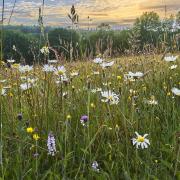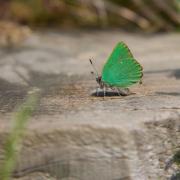In the pretty Oxfordshire town of Woodstock, a new art trail – running from May 13 to 21 – will be offering a microcosm of Oxfordshire Artweeks, the oldest and biggest festival of open studios and pop-up exhibitions in the country. During the historic main event, 2,000 artists, designers and makers welcome visitors to see their work and chat about their materials, methods and inspiration.
Beginning on Market Street, Darl-e and the Bear gallery showcases a selection of paintings from contemporary watercolours, inspired by memories, music and the landscape to industrial paintings of car plant interiors at Jaguar, Land Rover and BMW. Alongside, MM Plum and Caroline Parkes explore joy, grief and the journey to find happiness in chaotic, electric colours with exuberance and flair.
‘For my 50th birthday,’ smiles Caroline, ‘I was asked what I wanted as a gift, and what I coveted was a wonderful painting at the Darl-e & The Bear gallery. “But, wait a moment,” I told him, “What I really want is to paint something myself. And one day, even, to be displayed there!” Fast forward to Artweeks 2023 and that’s just what I will be doing!’

Caroline is exhibiting hedonistic and magical scenes from experiences she’s enjoyed, such as Wilderness Festival, Giffords Circus and Cirque du Soleil; one painting – of Sugar House Island in East London – was inspired by a trip to see a factory once owned by her family. ‘It was where the first fluorescent paint was developed. I knew that colour ran in my blood,’ laughs Caroline, whose motto is ‘Life’s too short for beige’.
Just a stone’s throw away, you’ll find captivating brushstrokes and an exciting energy in intriguing mixed-media abstractions exploring the theme of ‘wildness’. Addy Gardner’s large interpretations of the Windrush River and imagined places draw on contemporary questions of loss of biodiversity and climate change, whilst, nearby, Jane Greer’s layered landscapes celebrate the delight of plant dyes and pigments ground from local rocks and places.
The ground beneath our feet also inspires Woodstock potter Jane Topliss, who is inspired by the way you can transform what is, essentially, mud into beautiful pieces. In St Mary Magdalene Church, alongside ten other artists – including a textile artist, a printmaker, and a sculptor – her pottery celebrates palaeontology, which she studied before becoming a commercial pilot.

‘I had a childhood sitting in streams making mudpies, and a summer in South Dakota excavating mammoth bones,’ Jane explains. ‘I even had a trilobite on my 21st birthday cake, and loved the romantic idea of field trips to ancient sites uncovering the history of the world.
‘At first, I carved ammonite patterns into the surface of vases and pots. Then I started moulding small ammonites and trilobites from original fossils, adding these to the surface to highlight the contrast between the shape, colour and textures of the fossil and the smooth glossy curves of the vase or bowl. Ammonites and trilobites are ancient marine creatures that look like nautilus and woodlice respectively, and I am depicting that amazing moment when these creatures emerge from the bedrock and their fossil is uncovered for the first time in 200 million years.
‘There are parallels between the patience needed for palaeontology and for potting,’ she laughs. ‘When you embark on a project, you never know what the end point will be, which is exciting. You can manage the process, but you can’t control the results.’
Over the road, in the Gallery at Soldiers of Oxfordshire Museum, an Oxford Photographic Society exhibition includes a refreshing take on The Clarendon Building by Rob Farrands in which a tourist on a bus leans forward to snap the statues on the roof of the University of Oxford’s neoclassical Clarendon Building. To capture him in action and also draw these muses into the picture, Rob has angled the camera, creating an unusual composition in which you see the world through both the tourist’s and the photographer’s eyes. Meanwhile, the muses look back at you, creating a kind of visual circle. Tourist buses are notoriously garish in colour, so the choice to present this in monochrome encourages the viewer to focus on the detail. ‘Interestingly, revelation is achieved by a process of omission. Less becomes more as colour is stripped from the scene,’ says Rob.

The striking collection also includes an elegant other-worldly ‘Birch Trees and Rainbows’ by award-winning photographer Linda Wride, marking the contrast between the white silver birch trees, steps and decking, the brightly-coloured rainbow stripes on glass balustrades at the Greenwich Design District, London, and an architectural abstract of the candy-coloured metal bars on the exterior of Munich’s Museum Brandhorst.
While pop-up exhibitions are an easy way to discover the hidden talent of a many artists in a single space, a visit to a studio offers an in-depth insight into an artist’s practice, and Artweeks visitors can explore Canada and Vietnam in Suzanne O’Driscoll’s spacious home studio/gallery between Woodstock and Bladon Church, where Churchill is buried. A long drive leads to the heart of a lush former quarry, a secret terraced glade once part of the Blenheim Palace estate where a bright art space with a floating ceiling nestles; it seems to hang in the tree canopies below an ancient apple orchard of gnarled branches and blossom. As you enter this world of fronds, foliage and birdsong, you’ll find vibrant and joyful colour and gentle curves to match those of the Amazon rainforest.

Here, in a bold yet organic palette of greens, blues, oranges and browns, Suzanne’s paintings show flowers, nature, and meandering paths that draw the eye and the cycle of life. ‘The Canadian landscape is unusual in that, because it’s so enormous,’ she says, ‘it barely changes for hundreds of miles: forests and lakes stretch out across great swathes of country. It’s so unpopulated there’s a real sense of purity, and you feel so very small.
‘Vietnam, in contrast, is long, narrow and crammed with interest because the climate shifts as you travel from province to province,’ she continues. Her Vietnam collection focuses on buildings, markets and people bobbing in boats, and has a sense of adventure. ‘It’s a stunning place to visit. I’m always drawn to water and the way it meanders, moves and rests. In Vietnam it’s everywhere, and everyday life takes place on the water. The people decorate the fronts of their homes in the most wonderful ways. There’ll be a house painted in an Art Deco style next to one that looks like a castle, a chequerboard one alongside, and striped awnings everywhere. It’s a visual feast of brilliant colour and pattern. Even up in the rural north, amongst the islands and amazing granite hill rock features, the floating houses are painted beautifully.’
During Artweeks, Suzanne is also showing fine metal sculpture of multi-layered interlocking garden-inspired shapes cut with perfect precision from robust sheets of steel. With the apparent delicacy of papercut art, and tasteful yet bold enamelled colours, these fanfares of flowers and small birds nestling on boughs are light-hearted and elegant. While you might prefer not to paint the front of your Cotswold cottage the colours of a Vietnamese rainbow, these offer a charming way to add a touch of the exotic to the walls of an Oxfordshire house.
Oxfordshire Artweeks runs from May 6-29.
Five other top places to visit include:
- Peach Croft Farm Artists in Abingdon, a collection of lively new art – including A Goat with a Pearl Earring – and daily demos in a beautiful old barn setting from May 6-14 (Artweeks venue 15).
- The Stour Artists and Makers at Temple Mill Loft, a collection of art in wood, jewellery, pottery and blacksmithing against the backdrop of the first mill on the Stour. Open from May 13-21 (Artweeks venue 206).
- Sculpture at Kingham Lodge, a five-acre sculpture garden near Chipping Norton. Open from May 20-29 (Artweeks venue 264).
- The Biblio Press, a working letterpress studio at the heart of the University of Oxford’s historic Old Bodleian Library. Open May 20, 21, 27 & 28 (Artweeks venue 427).
- The Oxford home workshop of jeweller Tony Thomson, an intriguing and intimate space packed the tools of the trade and fascinating stones, fossils and more, as he celebrates 30 years of open studios in Jericho. Runs from May 20-29 (Artweeks venue 440).
For further information on these and hundreds of other venues, visit artweeks.org



























